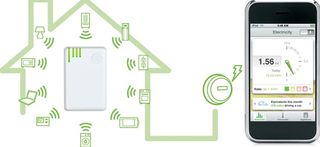The Internet of Things: A Seamless Network of Everyday Objects
Gone are the days of computers, smartphones and tablets being the only objects able to connect to the Internet. Today, nearly everything around us — from coffee pots and household lights to vending machines and cars — has the ability to be brought online to interact with other machines. This idea of physical objects communicating and interacting with each other online is referred to as the Internet of Things.

In a 2009 presentation, SAP Research's Stephan Haller defined the Internet of Things as "a world where physical objects are seamlessly integrated into the information network, and where the physical objects can become active participants in business processes."
This online network of physical objects is accomplished through the use of RFID tags and other types of sensors. Implanting these tags inside a physical object gives it the power to be monitored and controlled remotely through the Internet. This eliminates the need for humans to constantly enter and monitor data. Instead, objects can work directly with each other, without the need for a person to link them together.
While this technology is currently seen by most consumers through home-based smart products like thermostats, lights and security systems, in the future businesses are expected to fully integrate it into their operations in order to become more efficient.
History of the Internet of Things
Kevin Ashton, co-founder and executive director of the Auto-ID Center, is credited with coining the term the Internet of Things. Ashton said he first used the term in a presentation in 1999 he made to Proctor & Gamble on how to link the company's RFID supply chain technology to the Internet.
"If we had computers that knew everything there was to know about things — using data they gathered without any help from us — we would be able to track and count everything, and greatly reduce waste, loss and cost. We would know when things needed replacing, repairing or recalling, and whether they were fresh or past their best," Ashton wrote in a 2009 RFID Journal article on what he originally meant by the Internet of Things. "We need to empower computers with their own means of gathering information, so they can see, hear and smell the world for themselves, in all its random glory."
Since then, technology companies around the world have been feverishly trying to develop new ways to link the Internet with physical objects. Currently, there are more than 12 billion devices that can connect to the Internet. However, by 2015, IT giant Cisco projects there will be 25 billion, with that number jumping to 50 billion by 2020, nearly seven times the number of people on the planet.
Applications and examples of the Internet of Things
The Internet of Things is currently being applied in a wide variety of uses throughout the home, businesses, hospitals, cars and entire cities. The most common places everyday consumers see Internet-connected devices are in the home. Internet-connected objects, from thermostats and lights to smart outlets and key tracking devices, are used in the home to help owners save time and money. Being able to remotely monitor and control which devices are on and off at any certain time helps homeowners reduce monthly electric, gas and water bills.
The Internet of Things is seen similarly in businesses. Companies in every industry are incorporating Internet-connected devices into their operations as a way to save money. While the majority are using things temperature and lighting controls, some are figuring out more advanced ways to use the devices. Examples include vending machines that send signals to a business' computers when they're running low, or manufacturing equipment that can send warnings when it is malfunctioning.
But that's only one layer of what the Internet of Things is capable of. Its full potential can be seen when multiple devices are interacting and communicating with each other all at one time. For example, Cisco paints a picture of a sleeping employee who receives an email overnight letting them know their first appointment of the day is being pushed back 45 minutes. That email will then notify the employee's alarm clock, which will then readjust when it is set to go off. When the alarm does go off, the clock can then communicate with the coffee pot to start brewing a cup and let their car know they need to start defrosting those ice-covered windows.
Experts agree that as it becomes easier and easier to bring physical objects online, the opportunities presented by the Internet of Things are endless.
Follow Chad Brooks on Twitter @cbrooks76 or BusinessNewsDaily @BNDarticles. We're also on Facebook & Google+.
Sign up for the Live Science daily newsletter now
Get the world’s most fascinating discoveries delivered straight to your inbox.
